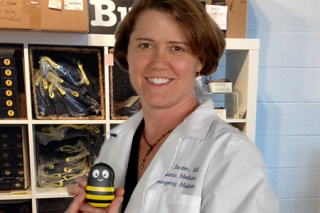Dr. Amy Baxter started thinking anew about the problem of pain when her son Max, then 4, had what she calls a “horrible’’ experience getting a group of four shots. He was hurting a lot, and it showed.
“I was embarrassed and angry,’’ Baxter recalls. “He became afraid of doctors.”
Baxter, a pediatric emergency physician and a pain researcher, later had a moment of discovery while driving home one day. She noticed that the steering wheel vibration from unbalanced tires temporarily made her hand numb.
Baxter got the idea of combining the vibration effect with a frozen gel pack accessory. She eventually created a new device called Buzzy.
The battery-powered, palm-sized device uses vibration — and cold — to block the action of pain nerves. The aim is to dull or eliminate sharp pain when patients receive shots or other types of injections, get their blood drawn or have to prick their own fingers. It can also offer pain relief from arthritis, injuries due to overuse of muscles, and minor aches, Baxter says.
The buzz on Buzzy has been positive: Clinicians say children and adults appreciate the device’s effect on needle pain.
Coincidentally or not, sales of Buzzy in U.S. hospitals are rising just as Medicare and health insurers are putting more emphasis on patient satisfaction.
This new emphasis is not just a promotional campaign. It’s about money. Medicare is using patient satisfaction to reward or penalize hospitals financially under the Affordable Care Act. Some private insurers are also basing payments on how pleased patients are with their care, according to a Kaiser Health News article.
“Any initiative to manage patients’ pain will certainly benefit a [health care] organization,’’ says Lorelle Wuerz, a vascular access specialist in New York City who uses Buzzy for IV starts, catheter insertions and blood draws for children and adults. “The patient experience is key to what we’re focused on in health care.”
In April, Medicare began publishing its new 5-star hospital ratings based on 11 facets of patient experience, including pain management. Adult patients are surveyed whether they are Medicare beneficiaries or not.
A very common fear
The Buzzy device addresses “needle phobia,’’ a major problem in health care.
Aversion to pain is natural. Most people can put aside that feeling briefly when being injected because of their awareness that the benefit outweighs the unpleasantness. But many adults, despite that awareness, still dread the pain from a medical needle. And most small children don’t even understand why the needle sometimes hurts. They just know it hurts.
A 2012 study found that 63 percent of children were afraid of needles, and about 25 percent of adults had the same fear, Baxter notes.
“Children get six times more shots than they did before 1983,’’ she says. “Needle fear is a huge public health problem.” Parents are refusing vaccines for their children, and diseases such as measles and pertussis, preventable through vaccinations, are spreading again after a long decline, Baxter says.
[youtube]https://youtu.be/CVMFUu3XVu0[/youtube]Bad shot experiences, such as what happened with Max, can breed fear of doctors, she adds.
The Buzzy idea was developed after Baxter formed MMJ Labs in 2006, and eventually the company made 1,000 Buzzys available for sale in 2009.
That year, Baxter received $1.1 million from the National Institutes of Health to do research and study how cold and vibration can affect the immunization experience.
Studies at Children’s Healthcare of Atlanta and elsewhere showed children had lower pain during blood draws and IV insertions using Buzzy as compared with using a cold spray.
Baxter says the vibration from the device has the added effect of dilating the veins, making blood easier to collect.
Eileen Murray, pain management coordinator at Children’s Healthcare of Atlanta, says, “Many kids find it really helpful when getting their injections.’’ The device needs more study to be considered the standard of care across the country, Murray says, adding, “It’s got great potential.”
“Immunizations are very important, and there are a lot of great things we can do to help children, especially with needle pain.”
Buzzy received FDA clearance for additional uses, including for stiff muscles and splinters, in August 2014. That year, the device hit $1 million in sales.
Baxter’s office in Edgewood is known informally as “The Hive.” The actual manufacture of Buzzys, for both hospital use and home care, is done in Suwanee. The cost of a device is $70 to $100, or a consumer version for $40. They come with “distraction cards’’ for children and pediatric staff.
More than 47,000 Buzzys have been sold so far, and they are used in more than 5,000 hospitals and clinics. The device is selling for home care as well for people who get regular injections.
Heather Oliveri, supervisor of phlebotomy at Rochester General Hospital in Rochester, N.Y., says the organization began to use Buzzy in pediatric centers two years ago. Now it’s used for adults as well throughout the hospital.
“There are a lot of people with needle phobia.” Oliveri says. Buzzy doesn’t necessarily make the needle experience pain-free, she adds. “You’ll still feel a tiny poke.”
“It’s a wonderful product. It takes the anxiety out of having your blood drawn,” Oliveri says.
Deb Bruene, nursing practice leader at University of Iowa Children’s Hospital, says staffers encourage use of the ice “wings” that go along with the Buzzy. Some children, however, prefer to use only the Buzzy, she says.
“Minimizing needle pain is really necessary for children due to the lasting implications of fear and anxiety associated with needles,’’ Bruene says. “We have tools that are easy to use and prevent needle pain. We really need to offer these readily to patients and families.”
Adult patients in the University of Iowa Healthcare system use Buzzy as well.
“My daughter, who is 18, hesitates to donate blood if she doesn’t have a Buzzy,” Bruene adds.

